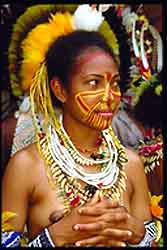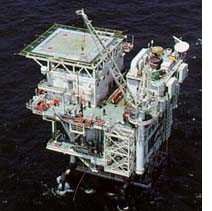Economy
 Two
distinct economies exist side-by-side in
Papua New Guinea - the traditional and the
cash economies. Two
distinct economies exist side-by-side in
Papua New Guinea - the traditional and the
cash economies.
The traditional sector, mainly subsistence
and semi-subsistence farming, supports about
85 per cent of the population. Most villages
are self-sufficient and small surpluses
of produce are available for trading.
Papua New Guinea exports mainly minerals
and agricultural commodities. The National
Government encourages more production onshore
for the needs of the population and for
export.
The economy is dominated by mineral and
petroleum projects. However, the agriculture,
forestry, fishing and manufacturing sectors
combined still account for a significant
portion of the nation's gross domestic product.
Total exports from Papua New Guinea are
valued at more than $US2 billion, major
exports being minerals (gold, silver, copper
and crude oil), timber, coffee, palm oil,
cocoa and copra. Papua New Guinea has experienced
a relatively even balance of trade over
the last five years, with exports marginally
exceeding imports.
Major imports consist of machinery and
equipment, manufactured goods, processed
food and chemicals.
The late 1980s saw the Papua New Guinea
economy experience a difficult period. The
closure of the world's largest copper mine,
on Bougainville Island, was a significant
set-back. That was compounded by reduced
world prices for a variety of agricultural
commodities central to the economy. The
Government took corrective measures by reducing
expenditure, devaluing the kina (the local
currency), restricting wage increases and
imposing restrained monetary policies.
Those measures and the development of several
new, large mineral and oil projects have
laid the foundation for strong growth for
future years.
 There
are extensive reserves of natural gas and
oil. The first oil production began at the
Kutubu field, in the Southern Highlands,
in mid-1992. A conservative estimate of
recoverable reserves at this field has been
put at around 270 million barrels. The Gobe
Oil Project, currently under construction
in the Gulf and Southern Highlands Provinces,
is scheduled to commence commercial oil
production in late 1997/early 1998 at a
rate of 50,000 barrels of oil per day. Other
known fields are yet to be developed. The
main mineral deposits are copper and gold
but there are also recoverable deposits
of other minerals. The Ok Tedi mine, in
the Western Province, is now a major producer
of copper and gold. The Porgera gold mine
in the Enga Province is one of the largest
in the world and is expected to produce
11.3 million ounces of gold over its 20
year life. The Lihir project in New Ireland
Province is estimated to have 13 million
ounces of gold which will be mined over
a 30 year period. The Misima gold mine in
the Milne Bay Province commenced operations
in 1989 and is producing an average of over
300,000 ounces of gold per year. There
are extensive reserves of natural gas and
oil. The first oil production began at the
Kutubu field, in the Southern Highlands,
in mid-1992. A conservative estimate of
recoverable reserves at this field has been
put at around 270 million barrels. The Gobe
Oil Project, currently under construction
in the Gulf and Southern Highlands Provinces,
is scheduled to commence commercial oil
production in late 1997/early 1998 at a
rate of 50,000 barrels of oil per day. Other
known fields are yet to be developed. The
main mineral deposits are copper and gold
but there are also recoverable deposits
of other minerals. The Ok Tedi mine, in
the Western Province, is now a major producer
of copper and gold. The Porgera gold mine
in the Enga Province is one of the largest
in the world and is expected to produce
11.3 million ounces of gold over its 20
year life. The Lihir project in New Ireland
Province is estimated to have 13 million
ounces of gold which will be mined over
a 30 year period. The Misima gold mine in
the Milne Bay Province commenced operations
in 1989 and is producing an average of over
300,000 ounces of gold per year.
The waters around Papua New Guinea contain
large stocks of marine resources. Within
the 200 mile economic zone are large varieties
of fish, including migrating schools of
tuna.
Forest products are one of Papua New Guinea's
major exports. There are 36 million hectares
of enclosed forest of which about 15 million
hectares of high quality tropical hardwoods
are considered to be suitable for development.
The Government is mindful of its obligations
to environmental heritage when promoting
the forest resource. Each major investment
project is carefully evaluated in terms
of its environmental impact and every effort
is made to develop appropriate guidelines
to meet the needs of both the local people
and the investors.
|